Today’s business world is nothing if not completely dependent on the tech that supports and drives it. We can hardly imagine our lives without a 24/7 high-speed internet connection, let alone our laptops, smartphones, and other gadgets. And while having your smart device on you at all times means that you can work at any time, from anywhere (which has its downsides as well), we rarely think about the security risks carrying all that information on us at all times can open up.
Whether your company requires its staff to bring in their own devices or work from company tech only, this guide will help you understand the security and cyber risks that plague modern-day operations and help you prepare for the worst, while doing your best to protect your data and devices.
1. Think before you buy
When purchasing any piece of hardware or software, take into account what you will be pairing it with. An older PC might not be able to run the operating system you need, or the apps you use daily. Yes, opting for a model that is no longer considered high tech will save you money, but it can also slow your processes down, and open you up for attack. Tech companies have been known to discontinue support for some of their older models or even older versions of their software, which also means cybercriminals have an easier way to enter through a previously guarded door.
Even if you find something at a discounted price, make sure you analyze how it will fit in with everything else you already own, and how it can be protected.
2. Uninstall what you don’t need
Smartphones and tablets often come with their own sets of preinstalled apps. By removing everything you don’t use and will never need, you’re not only freeing up disk space – you’re also removing potential backdoors for cyberattacks.
System apps are often replaced by downloadable apps, but the system app is still there and still subject to attack, as it is updated and worked on less frequently. By removing all of these built-in apps, you will be upping your chances of staying safe.
3. Paid vs. free apps
We are in no way saying that free apps are unsafe. But if you use an app often, and if it holds a lot of your business data (contact details, budgets, etc. – for example in a time management app), purchase the full version instead of using the free one. It will come with a bit of added security, and as a paying customer, you will have more leverage if a data leak does occur.
4. Set up a policy for apps and tools
If you require your employees to work on company tech, set up a policy that will prevent them from installing what they like on their devices. Make sure you install everything a staff member will need to get their job done (from standard apps like browsers and text processors to position-specific apps for different members of your team). After that, have all devices require an admin password before installing anything new and you will ensure nothing is added without your knowledge, thus preventing any potential malware to spread through your network.
5. Make sure you can track your devices
If a laptop or phone is stolen or lost, make sure you have a way of tracking them from a distance. For example, finding a Mac can be rather straightforward, if you have set things up right. You should also enable remote access if you can, which can either help you locate it, or wipe the data on it if you can’t recover it.
Needless to say, try to keep company tech on company premises as much as you can. We’re not saying you shouldn’t let employees take devices home, but make sure you have a policy in place for tracking where everything is, and who has taken their laptop out for a spin.
6. Tag and brand your devices
If a device gets stolen, the least you can do is make it harder for the thief to sell it.
Engrave your company logo or brand name on each device, or at least stick on a hard to remove sticker. Try to make it clear that the device belongs to you, and if one gets stolen, you can post a do not buy warning on your socials. It will probably won’t be seen by the thief, but you never know, you might just deter a potential dishonest buyer.
Bring Your Own Device and how to handle it
Last year, 50% of American businesses worked with BYOD policies, which means a whole other set of security measures are also required. Blacklist all apps that have high malware risks and ensure they’re not used by your staff. Train them in cybercrime prevention tactics and teach them how to spot potential dangers. Find a way to protect the data that is being accessed (not stored) from these personal devices, whether it be in the cloud or on your own servers.
Security should be at the top of your “things I can do to make work easier” list. It may not be the most interesting and thrilling of projects, but it sure carries a lot of weight.
Access the latest business knowledge in IT
Get Access





Comments
Join the conversation...